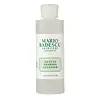What's inside
What's inside
 Key Ingredients
Key Ingredients

 Benefits
Benefits

 Concerns
Concerns

 Ingredients Side-by-side
Ingredients Side-by-side

Water
Skin ConditioningCoco-Betaine
CleansingSodium Lauroyl Glycinate
CleansingGlycerin
HumectantAcrylates Copolymer
Aloe Barbadensis Leaf Juice
Skin ConditioningPhenoxyethanol
PreservativeSodium Hydroxide
BufferingPropylene Glycol
HumectantSaccharomyces/Xylinum/Black Tea Ferment
Skin ConditioningBHT
AntioxidantEthylhexylglycerin
Skin ConditioningChamomilla Recutita Extract
Skin ConditioningOenothera Biennis Flower Extract
AstringentPotassium Sorbate
PreservativeSodium Benzoate
MaskingCitric Acid
BufferingWater, Coco-Betaine, Sodium Lauroyl Glycinate, Glycerin, Acrylates Copolymer, Aloe Barbadensis Leaf Juice, Phenoxyethanol, Sodium Hydroxide, Propylene Glycol, Saccharomyces/Xylinum/Black Tea Ferment, BHT, Ethylhexylglycerin, Chamomilla Recutita Extract, Oenothera Biennis Flower Extract, Potassium Sorbate, Sodium Benzoate, Citric Acid
Water
Skin ConditioningSodium Laureth Sulfate
CleansingMethyl Gluceth-20
HumectantLauryl Glucoside
CleansingSilica
AbrasivePropylene Glycol
HumectantGlycerin
HumectantAloe Barbadensis Leaf Juice
Skin ConditioningDisodium Cocoamphodiacetate
CleansingCoco-Betaine
CleansingAcrylates/C10-30 Alkyl Acrylate Crosspolymer
Emulsion StabilisingTriethanolamine
BufferingLactose
HumectantCellulose
AbsorbentPanthenol
Skin ConditioningParfum
MaskingPhenoxyethanol
PreservativeImidazolidinyl Urea
PreservativeAllantoin
Skin ConditioningPEG-40 Hydrogenated Castor Oil
EmulsifyingPolysorbate 20
EmulsifyingDisodium EDTA
Menthol
MaskingEthylhexylglycerin
Skin ConditioningHibiscus Sabdariffa Flower Extract
Skin ConditioningOctoxynol-12
EmulsifyingTocopheryl Acetate
AntioxidantHydroxypropyl Methylcellulose
Emulsion StabilisingCI 77891
Cosmetic ColorantSodium Hyaluronate
HumectantPrunus Armeniaca Fruit Extract
Skin Conditioning1,2-Hexanediol
Skin ConditioningCaprylyl Glycol
EmollientCI 77491
Cosmetic ColorantRosa Gallica Flower Extract
AstringentRosa Damascena Flower Oil
MaskingLimonene
PerfumingWater, Sodium Laureth Sulfate, Methyl Gluceth-20, Lauryl Glucoside, Silica, Propylene Glycol, Glycerin, Aloe Barbadensis Leaf Juice, Disodium Cocoamphodiacetate, Coco-Betaine, Acrylates/C10-30 Alkyl Acrylate Crosspolymer, Triethanolamine, Lactose, Cellulose, Panthenol, Parfum, Phenoxyethanol, Imidazolidinyl Urea, Allantoin, PEG-40 Hydrogenated Castor Oil, Polysorbate 20, Disodium EDTA, Menthol, Ethylhexylglycerin, Hibiscus Sabdariffa Flower Extract, Octoxynol-12, Tocopheryl Acetate, Hydroxypropyl Methylcellulose, CI 77891, Sodium Hyaluronate, Prunus Armeniaca Fruit Extract, 1,2-Hexanediol, Caprylyl Glycol, CI 77491, Rosa Gallica Flower Extract, Rosa Damascena Flower Oil, Limonene
Ingredients Explained
These ingredients are found in both products.
Ingredients higher up in an ingredient list are typically present in a larger amount.
Aloe Barbadensis Leaf Juice comes from leaves of the aloe plant. Aloe Barbadensis Leaf Juice is best known for helping to soothe sunburns. It is also anti-inflammatory, moisturizing, antiseptic, and can help heal wounds.
Aloe is packed with good stuff including Vitamins A, C, and E. These vitamins are antioxidants, which help fight free-radicals and the damage they may cause. Free-radicals are molecules that may damage your skin cells, such as pollution.
Aloe Barbadensis Leaf Juice also contains sugars. These sugars come in the form of monosaccharides and polysaccharides, folic acid, and choline. These sugars are able to help bind moisture to skin.
It also contains minerals such as calcium, 12 anthraquinones, fatty acids, amino acids, and Vitamin B12.
Learn more about Aloe Barbadensis Leaf JuiceCoco-Betaine is the natural version of Cocamidopropyl Betaine. It is often derived from coconuts.
Coco-Betaine is a surfactant, meaning it helps remove dirt and oil from the skin.
Ethylhexylglycerin (we can't pronounce this either) is commonly used as a preservative and skin softener. It is derived from glyceryl.
You might see Ethylhexylglycerin often paired with other preservatives such as phenoxyethanol. Ethylhexylglycerin has been found to increase the effectiveness of these other preservatives.
Glycerin is already naturally found in your skin. It helps moisturize and protect your skin.
A study from 2016 found glycerin to be more effective as a humectant than AHAs and hyaluronic acid.
As a humectant, it helps the skin stay hydrated by pulling moisture to your skin. The low molecular weight of glycerin allows it to pull moisture into the deeper layers of your skin.
Hydrated skin improves your skin barrier; Your skin barrier helps protect against irritants and bacteria.
Glycerin has also been found to have antimicrobial and antiviral properties. Due to these properties, glycerin is often used in wound and burn treatments.
In cosmetics, glycerin is usually derived from plants such as soybean or palm. However, it can also be sourced from animals, such as tallow or animal fat.
This ingredient is organic, colorless, odorless, and non-toxic.
Glycerin is the name for this ingredient in American English. British English uses Glycerol/Glycerine.
Learn more about GlycerinPhenoxyethanol is a preservative that has germicide, antimicrobial, and aromatic properties. Studies show that phenoxyethanol can prevent microbial growth. By itself, it has a scent that is similar to that of a rose.
It's often used in formulations along with Caprylyl Glycol to preserve the shelf life of products.
Propylene Glycol is an odorless, colorless liquid. As a humectant, it helps skin retain moisture. It also aids in delivering active ingredients.
Another role of this ingredient is preventing a product from melting or freezing. Propylene glycol also adds antimicrobrial properties to a product, elongating product lifespan.
This ingredient is considered an organic alcohol and commonly added into both cosmetics and foods.
Those with sensitive skin or conditions may develop a rash when using this ingredient.
Learn more about Propylene GlycolWater. It's the most common cosmetic ingredient of all. You'll usually see it at the top of ingredient lists, meaning that it makes up the largest part of the product.
So why is it so popular? Water most often acts as a solvent - this means that it helps dissolve other ingredients into the formulation.
You'll also recognize water as that liquid we all need to stay alive. If you see this, drink a glass of water. Stay hydrated!
Learn more about Water